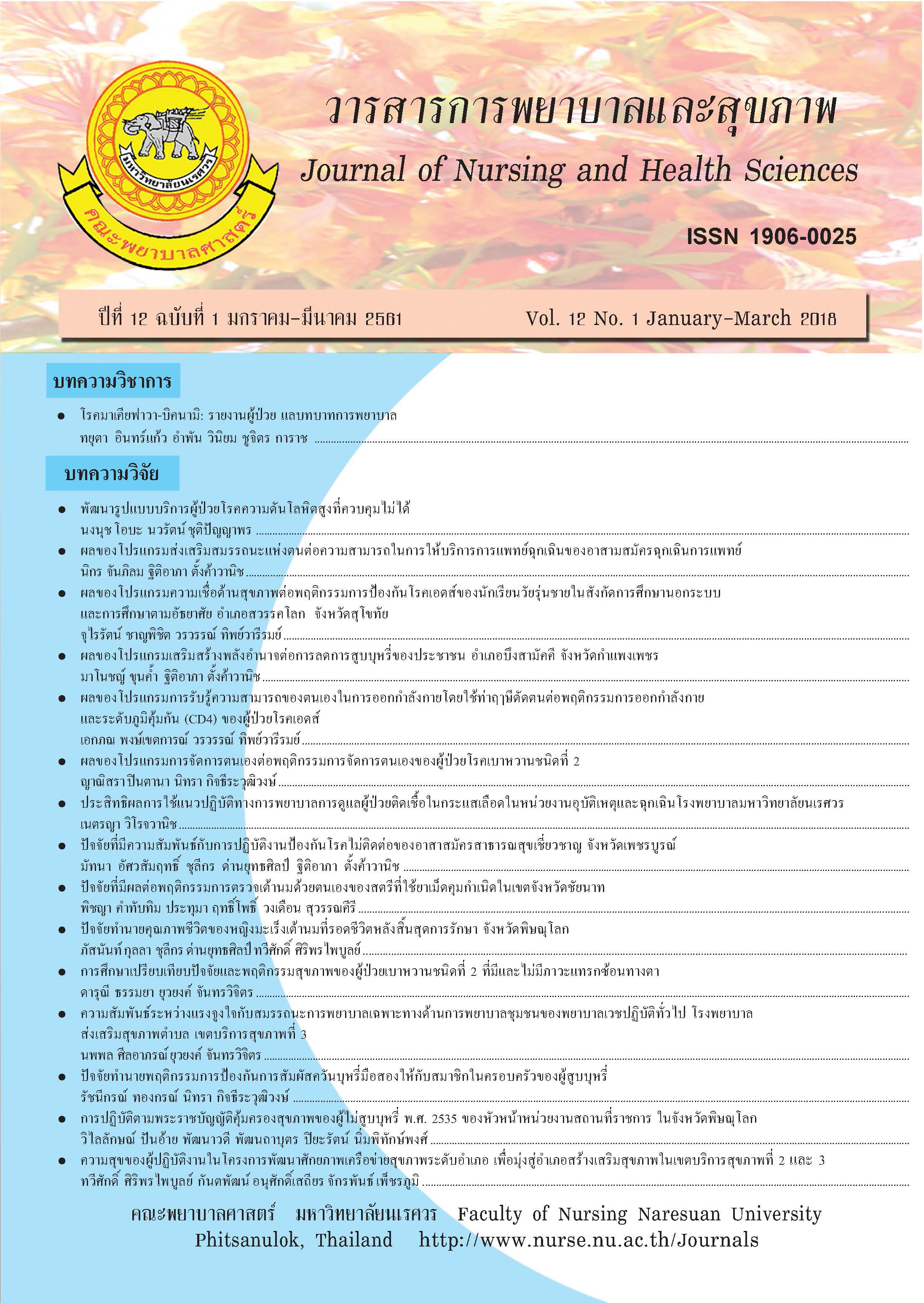Factors Affected to Breast Self-examination Behavior among Women Used Contraceptive Pills in Chainat Province
Main Article Content
Abstract
This descriptive research aimed to study breast self-examination behavior among women used contraceptive pills and factors predicting the behavior of these women. The samples selected by sampling with replacement method were 217 women used contraceptive pills in Chainat province. The research instruments applied Health Belief Model by Becker (1974) as the conceptual framework including 1) modifying factor 2) individual perception 3) cue to action factor, and 4) breast self-examination behavior. The validity of content validity index : (CVI) between .83 to .93. The questionnaire of knowledge about breast cancer and breast self-examination was tested using the KR-20 reliability test, which showed a result of .81.The validity of other questionnaire were tested using Combach’s Alpha Coefficient and the result were .83 to .90. The data were analyzed by descriptive statistics, Spearman and Pearson product moment correlation coefficient, and Stepwise multiple regression analysis. The result revealed that: 1. The mean score of breast self-examination behavior among women used contraceptive pills was high level ( = 2.37, S.D. = .32) 2. The overall health belief was at high level; ( = 2.35 , S.D. = .21) on the other hand, perceived barriers was at moderate level. ( = 1.78 , S.D. = .49) Furthermore, cue to action factor and modifying factor as knowledge about breast cancer ( = 2.65 , S.D. = .45) and breast self-examination factor ( = 12.33 , S.D. = 1.91) were at high level also. 3. Individual perception as perceived risk factor (r = .488), cue to action factor (r = .425), and modifying factor as knowledge about breast cancer and breast self-examination factor (r = .326) were significantly positive moderate correlation with breast self-examination behavior among women used contraceptive pills at p < .01 4. The significant factors predicted breast self-examination behavior were Individual perception as perceived risk factor, cue to action factor and modifying factor as knowledge about breast cancer and breast self-examination factor which accounted for 31.0% The square of multiple correlation coefficient (coefficient of determination) was R2 = .310
Article Details
References
เต้านมของสตรีและปัจจัยที่มีความสัมพันธ์กับ
พฤติกรรมการป้องกันมะเร็งเต้านม (วิทยานิพนธ์
ปริญญาพยาบาลศาสตรมหาบัณฑิต). นครปฐม:
มหาวิทยาลัยคริสเตียน.
ดาริน โต๊ะกานิ. (2551). ปัจจัยที่มีอิทธิพลต่อพฤติกรรม
การตรวจเต้านมด้วยตนเองของสตรีที่มารับบริการ
ในคลินิกวัยทองของโรงพยาบาลในสามจังหวัด
ชายแดนภาคใต้ (วิทยานิพนธ์ปริญญาพยาบาล
ศาสตรมหาบัณฑิต). กรุงเทพฯ: มหาวิทยาลัย
นราธิวาสราชนครินทร์. นราธิวาส.
บุญใจ ศรีสถิตนรากูร. (2553). ระเบียบวิธีการวิจัยทาง
พยาบาลศาสตร์.(พิมพ์ครั้งที่ 5). กรุงเทพฯ:
ยูแอนด์ไออินเตอร์มีเดีย.
ประภาเพ็ญ สุวรรณ. (2542). ทัศนคติ: การวัดและการ
เปลี่ยนแปลงพฤติกรรมอนามัย. กรุงเทพฯ:
วัฒนาพานิช.
ปราณปรียา โคสะสุ. (2552). พฤติกรรมการตรวจเต้านม
ด้วยตนเอง ของสตรีอาสาสมัครสาธารณสุข
จังหวัดอุบลราชธานี (วิทยานิพนธ์ปริญญา
พยาบาลศาสตรมหาบัณฑิต). อุบลราชธานี:
มหาวิทยาลัยราชภัฏ.
วาสนา หลาบหนองแสง. (2553). ปัจจัยที่มีผลต่อการ
ตรวจเต้านมด้วยตนเองในสตรีเขตเทศบาลเมือง
ร้อยเอ็ด จังหวัดร้อยเอ็ด (วิทยานิพนธ์ปริญญา
พยาบาลศาสตรมหาบัณฑิต). กรุงเทพฯ:
จุฬาลงกรณ์มหาวิทยาลัย.
สถาบันมะเร็งแห่งชาติ กระทรวงสาธารณสุข. (2557)
ทะเบียนมะเร็งระดับโรงพยาบาล พ.ศ. 2556.
สำนักงานสถิติแห่งชาติ. (2556). การสำรวจอนามัย
การเจริญพันธ์ พ.ศ. 2555. สืบค้นจาก http://
www.ryt9.com/s/nso/1100742
สำนักงานสาธารณสุขจังหวัดชัยนาท. (2557). สรุป
ผลการดำเนินงานตามนโยบายและตัวชี้วัด
พ.ศ. 2556. สืบค้นจาก http://203.157.210.2/
chainat/Supervision%20Guidelines%202557.
html
สำนักโรคไม่ติดต่อ กรมควบคุมโรค กระทรวงสาธารณ
สุข (2559). รายงานประจำปี 2558. สืบค้นจาก
http://thaincd.com/document/file/download/
paper-manual/Annual-report-2015.pdf
สืบค้น จาก https://www.m-society.go.th/article_
attach/11832/16129.pdf
หะสัน มูหาหมัด. (2556). ปัจจัยเสี่ยงต่อการเป็นมะเร็ง
เต้านม. สืบค้นจาก http://www.thaibreastcancer.
com/ca-137/
อาคม ชัยวีระวัฒนะ, เสาวคนธ์ ศุกรโยธิน, วีรวุฒิ อิ่ม
สำราญ, และธีรวุฒิ คูหะเปรมะ. (2551). แนวทาง
การตรวจคัดกรองวินิจฉัยและรักษาโรคมะเร็ง
เต้านม (พิมพ์ครั้งที่ 1). กรุงเทพฯ: โฆสิต
การพิมพ์.
American Cancer Society. (2015). Global Cancer Facts
& Figures 3rd Edition. สืบค้นจาก http://
www.cancer.org/acs/groups/content/@
research/documents/document/acspc-044
738.pdf
Becker. M. H. (1974). The health belief model and
personal health behavior. New Jersy: Health
education monographs.
Ogletree, R. J., Hammig, D. J. C., and Birch, D.A.,
(2004). Knowledge and intention of ninth-grade
girls after a breast self-examination programe.
Journal of School Health, 74(9), 365-369.
World Cancer Research Fund International. (2015).
Breast cancer statistics. Retrieved from http://
www.wcrf.org/int/cancer-facts-figures/dataspecific-
cancers/breast-cancer-Statistics
World Health Organization. (2012). Breast cancer:
prevention and control. Retrieved from http://
www.who.int/cancer/detection/breastcancer/
en/index3.html


